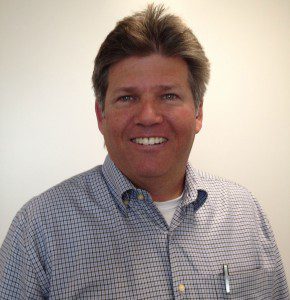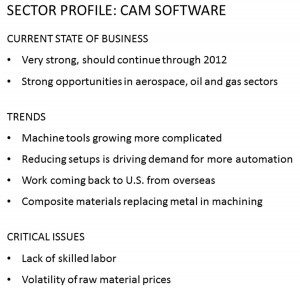2012 State of the Industry: Metal Cutting Software
Forecast: Software must support demand for automation by driving the growth of more complicated machine tools that reduce setups.
Posted: January 10, 2012
Forecast: Software must support demand for automation by driving the growth of more complicated machine tools that reduce setups.
 Jim Huddy
Jim Huddy
National Sales Manager, CGTech
Provider of numerical control verification software for machine tools that simulates, verifies, analyzes, and optimizes NC tool paths for cutting materials.
CURRENT STATE OF BUSINESS
From our perspective, the current state of business is very strong. The shops we work with are very busy and, as a result, we are having a record sales year in the U.S.
This has been driven predominantly by aerospace, but most industries are showing strength. Many of our oil and gas customers are so busy that they don’t have time to implement new software or attend training, even though they recognize the value. The shops that are overloaded are buying new NC machines, and these new machines are more complex than they were five years ago. The trend is for the machine tool manufacturers to continue to design ever-more complicated machine tools. We recently attended the “multi-tasking turning center” demo day at a machine tool OEM that announced their new multi-axis mill/turn machine. These are not simple machines.
As the machine tool builders add new features to each release, some CAM companies seem to be struggling to keep up. As a result, we have customers who are struggling to use their two-year-old CAM system to create programs for a machine they just purchased last month. Some CAM systems simply don’t have the required algorithms, so our customers create the programs they need by hand-stitching NC programs together. This creates opportunities for us because they need to simulate that somehow; it’s simply too risky to prove-out a program on an expensive machine tool without simulating it first.
MAJOR TRENDS
Many manufacturers are seeking to reduce the number of set-ups involved with machining a part. This, in turn, also reduces the amount of operator involvement and means that one operator can oversee many machines. Reducing set-ups generally requires sophisticated multi-axis CNC machinery and automation tools such as robots and pallet shuttle systems. All of this automation adds complication to the prove-out process, increasing the need for simulation software.
Another major trend is that many companies that previously took their manufacturing offshore are finding that it makes economic sense to bring the work back. According to the Reshoring Initiative, 60 percent of manufacturers use rudimentary total cost models and ignore 20 percent of the cost of offshoring. The Reshoring Initiative was founded by Harry Moser, the former president of a machine tool builder, to help manufacturers and suppliers recognize the real cost of both offshoring and reshoring. His message is spreading and we are seeing a stronger U.S. manufacturing base as a result.
Many years ago we recognized the trend towards using composite materials to replace parts traditionally milled from metal. Our investment in composite programming and simulation software is paying off as more and more manufacturers implement automated composite machinery. Some of this technology is transferring to our recently released product for programming and simulating automated drilling and fastening equipment. With both composite parts and large airframe components, the cost of a mistake is very high. We develop tools that help prevent mistakes from happening.
CRITICAL ISSUES
The biggest issue we hear over and over again is that shops can’t find qualified employees – and this is limiting their growth. We have been facing the same challenge. Our company has been growing rapidly and it seems we are constantly looking for qualified employees with the right technical background. We support organizations like the National Tooling and Machining Association (NTMA; Independence, OH) and Society of Manufacturing Engineers (SME; Dearborn, MI) because they are doing all they can to make manufacturing jobs cool to students again.
When companies can’t find the employees they need, they must find ways to become more efficient with the employees that they have. This is done with technology that allows them to do more with less bodies.
Another critical issue is the volatility in the price of raw materials. This continues to be a challenge for many of our customers. Machine shops often run at a very tight profit margin, so if the price of raw materials increases 10 percent from the time a quote is made, any profitability of the job is lost.
We are actively increasing the strength of our partnerships with the machine tool builders for the benefit of our mutual customers. Most of the major machine tool builders are now providing models for use in the simulation process. We also work closely with most CAD/CAM companies to tightly integrate our simulation with the CAM programming step.
We continue to work closely with the NTMA and we attend as many of the meeting round tables as possible to learn what challenges our industry is currently facing. By listening to our customers and partners we can add enhancements to our products to make them more efficient. For example, to address the trend of increased automation, we have done a ton of work to develop our robot simulation and programming capabilities.
CGTech, 9000 Research Drive, Irvine, CA 92618, 949-753-1050, Fax: 949-753-1053, www.cgtech.com.















